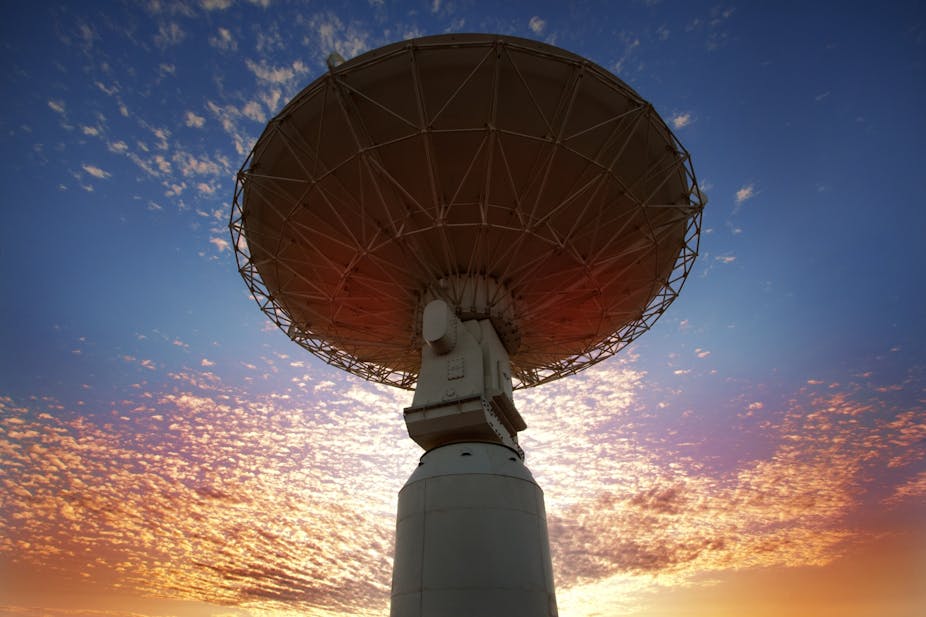Western Australia is world-famous for its vast mineral reserves, but if the astronomy community has its way, the state will soon be equally famous for advancing our understanding of the universe and the laws of physics.
The abundance of sparsely populated, wide-open spaces makes it one of the best places in the world for astronomy research and for building large, sensitive radio telescopes.
It is for this reason that Western Australia is the focus for Australia and New Zealand’s combined bid for the Square Kilometre Array (SKA) telescope. And, at some point in the next few months, we should know whether that bid has been successful.
Regardless of the outcome of the SKA bid, Western Australia can look forward to a scientific boom in coming years, with outstanding new telescopes being built.
A team at the International Centre for Radio Astronomy Research (ICRAR) (including myself), primarily based at Curtin University in Perth, is leading the construction of one such telescope – the Murchison Widefield Array (MWA).
The MWA is a radio telescope consisting of 4,096 antennas, not unlike the antennas used for television or FM radio reception. These antennas are grouped into 128 clumps of 32 antennas each. The 128 clumps are spread over an area 3km in diameter.
Radio signals are received at each of the 4,096 antennas and combined using supercomputing facilities. The combined signal can then be analysed to detect and creates images of radio emissions produced by objects in the nearby and distant universe – objects including nearby and distant galaxies, or objects within our own galaxy, such as rotating neutron stars called pulsars.
It is particularly important to locate a telescope such as the MWA in a radio-quiet environment, as it operates at radio frequencies between 80 and 300 megahertz. This range includes the FM radio band which runs from approximately 87 to 108 MHz.
In order for the MWA to detect the whisper-faint radio waves emitted from objects that existed soon after the universe came into existence, the instrument has to be located well away from the FM transmitters that abound in populated areas.
When you’re listening to your favourite FM radio station, you’re likely within 50km of the transmitter. But when you’re listening for events from the outer edges of our universe, you’re talking about distances well beyond those of the human scale.
Even though the power of the FM radio station transmitter is insignificant compared with the radiated power from cosmological objects, the close proximity of the transmitter means it interferes strongly with radio telescopes searching for the cosmological signals.
Fortunately, the Murchison region of Western Australia is a great example of a radio-quiet environment. The region has a population density of roughly 0.002 people per square kilometre and is located only a few hundred kilometres away from the regional coastal city of Geraldton. As such, the area is remote, it has a low population, but is still conveniently close to major infrastructure.
(For comparison, the Murchison region covers approximately the same area as The Netherlands which has 400 people per square kilometre — a population density 200,000 times greater than the Murchison).
So, what will the MWA be used for? Well, a range of things:
to make the most detailed radio observations of our own sun during a period when it will reach solar maximum. This will allow the MWA to monitor solar storms that can affect expensive space-based and Earth-based assets
to study the remnants of dead stars in our galaxy
to study the millions of galaxies reaching back to the beginning of the universe, and
to search for evidence of the formation of the first stars and galaxies, less than one billion years after the Big Bang – one of the hottest topics in cosmology.

The MWA is an official Precursor for the SKA (a technology demonstrator telescope on one of the two candidate SKA sites). If Australia and New Zealand’s bid for the SKA is successful, it would be centred at CSIRO’s Murchison Radioastronomy Observatory (MRO) with array stations spread across Australia and in New Zealand (see map above).
For the last two years, a prototype MWA instrument has been producing quality data from the MRO, with a flood of these results now starting to hit the international peer-reviewed astronomical literature. This demonstrates Western Australia’s suitability as a location for radio astronomy, and as a fantastic location for the SKA.
Importantly, given population growth trends, it is likely the Murchison region will remain an excellent place for radio astronomy for the next 50 years.
This is significant because areas such as Murchison are dwindling in size and number around the world, due to population growth and the ever-increasing prevalence of mobile phones and other sources of human-made radio interference. For this reason the MRO has been afforded formal Radio Quiet Zone protection by the Australian Communications and Media Authority.
Western Australia is famous for its rich mineral deposits and profitable mining industry. But if we astronomers have our way, WA will soon be widely recognised for its scientific achievements as well, thanks to the MWA and other next-generation radio telescopes.

